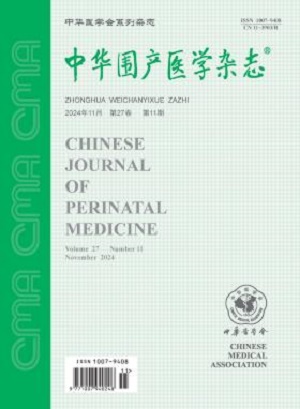Maternal and neonatal outcomes in pregnant women with COVID-19: a systemic review
Yuming Cao, Huijun Chen, Juanjuan Guo, Xuechen B. Yu, Xue Wen, Yuan-zhen Zhang
求助PDF
{"title":"Maternal and neonatal outcomes in pregnant women with COVID-19: a systemic review","authors":"Yuming Cao, Huijun Chen, Juanjuan Guo, Xuechen B. Yu, Xue Wen, Yuan-zhen Zhang","doi":"10.3760/CMA.J.CN113903-20200402-00298","DOIUrl":null,"url":null,"abstract":"Objective: To fully understand the maternal and neonatal outcomes in pregnant women with COVID-19 and explore the evidence of intrauterine vertical transmission of 2019-nCoV by analyzing clinical and laboratory information in peer-reviewed publications on COVID-19 in pregnant women Methods: PubMed, Embase, China National Knowledge Infrastructure, China Academic Journals, and Wanfang Databases were searched to retrieve articles on COVID-19 in pregnancy published from December 1, 2019, to April 9, 2020 In addition, the World Health Organization COVID-19 Database and the reference lists in each included article were also searched All included cases were positive for 2019-nCoV nucleic acid with maternal and neonatal outcomes regardless of delivery or not Clinical manifestations, perinatal and neonatal outcomes were analyzed systematically Results: This study reviewed 29 publications involving 146 pregnant women who tested positive for 2019-nCoV nucleic acid and their 116 newborns (including two twins) Five cases of severe COVID-19 and three cases of unidentified type that were admitted to ICU for treatment were severe symptoms, accounting for 5 5% (8/146) of all cases Totally, 69 9% (102/146) of the women underwent cesarean section and 8 2% (12/146) gave birth vaginally Thirty (20 5%) women continued their pregnancies One case (0 7%, 1/146) terminated the pregnancy at 26 weeks of gestation due to bidirectional affective disorder and one (0 7%, 1/146) received artificial abortion at 6 weeks of gestation Fever (58 2%, 85/146) and cough (32 9%, 48/146) were the most common symptoms However, 15 8% (23/146) of the pregnant women were asymptomatic on admission and symptoms appeared or became worse after delivery in 20 5% (30/146) Lymphocytopenia (49 6%, 56/113) and elevated C-reactive protein (58 4%, 66/113) were the main laboratory findings The most common computed tomography (CT) finding was bilateral multiple patchy ground-glass opacity in lungs (79 7%, 94/118) The outcomes of 92 2% (107/116) of the newborns were good, and the rest 7 8% (9/116) showed different abnormalities of varying degrees Among the nine newborns, six showed different degrees of dyspnea, cyanosis and vomiting including one died of multiple organ failure and disseminated intravascular coagulation;one tested positive for viral nucleic acid 36 hours after birth;one was stillbirth due to unknown reason, but intrauterine vertical transmission was excluded;one neonatal death in a critically ill mother undergoing cesarean delivery Conclusions: Pregnant women are less likely to progress to severe COVID-19 and mostly have a good outcome Despite reports of adverse neonatal outcomes, evidence of intrauterine vertical transmission of 2019-nCoV remains insufficient Copyright © 2020 by the Chinese Medical Association","PeriodicalId":52320,"journal":{"name":"中华围产医学杂志","volume":"23 1","pages":"447-455"},"PeriodicalIF":0.0000,"publicationDate":"2020-07-16","publicationTypes":"Journal Article","fieldsOfStudy":null,"isOpenAccess":false,"openAccessPdf":"","citationCount":"1","resultStr":null,"platform":"Semanticscholar","paperid":null,"PeriodicalName":"中华围产医学杂志","FirstCategoryId":"3","ListUrlMain":"https://doi.org/10.3760/CMA.J.CN113903-20200402-00298","RegionNum":0,"RegionCategory":null,"ArticlePicture":[],"TitleCN":null,"AbstractTextCN":null,"PMCID":null,"EPubDate":"","PubModel":"","JCR":"Q4","JCRName":"Medicine","Score":null,"Total":0}
引用次数: 1
引用
批量引用
Abstract
Objective: To fully understand the maternal and neonatal outcomes in pregnant women with COVID-19 and explore the evidence of intrauterine vertical transmission of 2019-nCoV by analyzing clinical and laboratory information in peer-reviewed publications on COVID-19 in pregnant women Methods: PubMed, Embase, China National Knowledge Infrastructure, China Academic Journals, and Wanfang Databases were searched to retrieve articles on COVID-19 in pregnancy published from December 1, 2019, to April 9, 2020 In addition, the World Health Organization COVID-19 Database and the reference lists in each included article were also searched All included cases were positive for 2019-nCoV nucleic acid with maternal and neonatal outcomes regardless of delivery or not Clinical manifestations, perinatal and neonatal outcomes were analyzed systematically Results: This study reviewed 29 publications involving 146 pregnant women who tested positive for 2019-nCoV nucleic acid and their 116 newborns (including two twins) Five cases of severe COVID-19 and three cases of unidentified type that were admitted to ICU for treatment were severe symptoms, accounting for 5 5% (8/146) of all cases Totally, 69 9% (102/146) of the women underwent cesarean section and 8 2% (12/146) gave birth vaginally Thirty (20 5%) women continued their pregnancies One case (0 7%, 1/146) terminated the pregnancy at 26 weeks of gestation due to bidirectional affective disorder and one (0 7%, 1/146) received artificial abortion at 6 weeks of gestation Fever (58 2%, 85/146) and cough (32 9%, 48/146) were the most common symptoms However, 15 8% (23/146) of the pregnant women were asymptomatic on admission and symptoms appeared or became worse after delivery in 20 5% (30/146) Lymphocytopenia (49 6%, 56/113) and elevated C-reactive protein (58 4%, 66/113) were the main laboratory findings The most common computed tomography (CT) finding was bilateral multiple patchy ground-glass opacity in lungs (79 7%, 94/118) The outcomes of 92 2% (107/116) of the newborns were good, and the rest 7 8% (9/116) showed different abnormalities of varying degrees Among the nine newborns, six showed different degrees of dyspnea, cyanosis and vomiting including one died of multiple organ failure and disseminated intravascular coagulation;one tested positive for viral nucleic acid 36 hours after birth;one was stillbirth due to unknown reason, but intrauterine vertical transmission was excluded;one neonatal death in a critically ill mother undergoing cesarean delivery Conclusions: Pregnant women are less likely to progress to severe COVID-19 and mostly have a good outcome Despite reports of adverse neonatal outcomes, evidence of intrauterine vertical transmission of 2019-nCoV remains insufficient Copyright © 2020 by the Chinese Medical Association
感染COVID-19的孕妇的孕产妇和新生儿结局:一项系统综述
目的:通过分析同行评审出版物中有关孕妇COVID-19的临床和实验室信息,全面了解COVID-19孕妇的孕产妇和新生儿结局,探索COVID-19宫内垂直传播的证据。检索PubMed、Embase、中国国家知识基础设施、中国学术期刊、万方数据库,检索2019年12月1日至2020年4月9日期间发表的关于妊娠期COVID-19的文章,检索世界卫生组织COVID-19数据库及每篇收录文章的参考文献列表,所有纳入病例均为2019- ncov核酸阳性,无论是否分娩,均为孕产妇和新生儿结局。系统分析围产儿及新生儿结局。本研究回顾了29篇文献,涉及146例新型冠状病毒核酸检测阳性孕妇及其116例新生儿(包括2对双胞胎),重症病例5例,不明类型3例,重症症状进入ICU治疗,占全部病例的5.5%(8/146),其中剖宫产占69.9%(102/146),顺产占82%(12/146),继续妊娠30例(20.5%),1例(0.7%)。1/146)在妊娠26周因双向情感障碍终止妊娠,1(0.7%,1/146)在妊娠6周人工流产,发热(58.2%,85/146)和咳嗽(32.9%,48/146)是最常见的症状,但15.8%(23/146)的孕妇入院时无症状,20.5%(30/146)分娩后出现或加重症状,淋巴细胞减少(49.6%,56/113)和c反应蛋白升高(58.4%)。66/113)为主要的实验室表现,最常见的CT表现为双侧肺部多发性斑片状毛玻璃影(79.7%,94/118),92.2%(107/116)新生儿预后良好,其余78.8%(9/116)新生儿表现不同程度的不同异常。1例出生后36小时病毒核酸检测呈阳性;1例原因不明死产,排除宫内垂直传播;1例危重症产妇剖宫产新生儿死亡。尽管有不良新生儿结局的报道,但2019-nCoV宫内垂直传播的证据仍然不足版权所有©中华医学会2020
本文章由计算机程序翻译,如有差异,请以英文原文为准。


